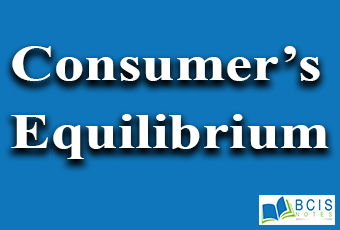
Consumer’s Equilibrium
A consumer’s equilibrium is defined as a point where he maximized the level of his satisfaction, given his resources and another condition. At equilibrium, the consumer is supposed (1) to have spent his entire income on the goods and services he consumes, (2) to have attained the optimum allocation of resources on various goods and services he consumes and (3) to have achieved an optimum quantity of each goods and services at the given prices.
Assumptions of consumer equilibrium
1. The consumer must be rational.
2. The consumer must have a budget line and indifference map.
3. The prices of the two goods remain unchanged.
4. The producer has to maximize utility by spending a fixed budget on two goods.
Conditions for consumer’s equilibrium
1. A given budget line must be tangent to an indifference curve, or the marginal rate of substitution between commodity X and commodity Y (MRSx,y) must be equal to the price ratio between the two goods
2. At the point of equilibrium, the indifference curve must be convex to the origin.

According to figure E point is the consumer’s equilibrium where two conditions for equilibrium (GH budget line is tangent to the IC2 and IC2 is convex to the origin) are satisfied. Hence, the consumer gets maximum satisfaction by spending the total budget on combination E which contains OQ2 units of commodity Y and OQ1 commodity X.
Budget line or Price Line: The budget line or price line shows all the combinations of two goods that can be purchased using all of the consumer’s budget at the given prices. Only purchases on the budget line use all of the consumer’s budget. The equation for the budget line is:
B=PxX+PyY
If the budget of the consumer is Rs 24 to spend on X and Y goods. Also, the price of X and Y are Rs 6 and Rs 2 respectively. We can derive the budget constraint or the budget line.
| Combination | X-good
(Rs 6 per unit) |
Y-good
(Rs 2 per unit) |
Total budget
B=PxX+PyY |
|
A |
0 | 12 | 24 |
|
B |
1 | 9 |
24 |
|
C |
2 | 6 |
24 |
|
D |
3 | 3 |
24 |
| E | 4 | 0 |
24 |
You may also like: Substitution Effect

Leave a Reply